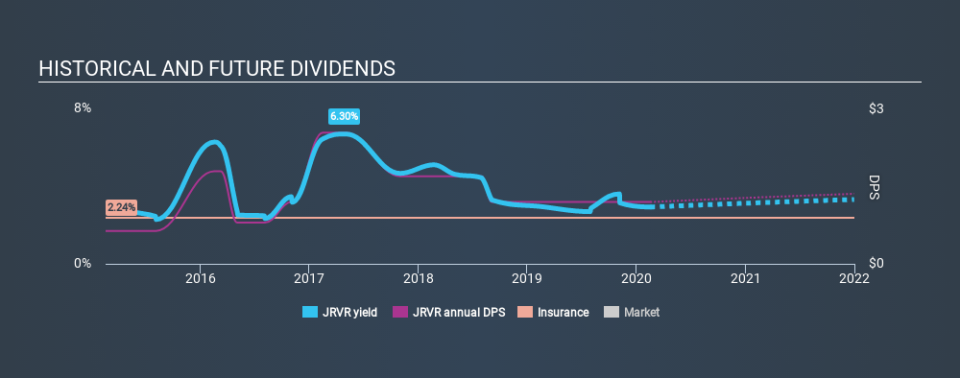Is James River Group Holdings, Ltd. (NASDAQ:JRVR) An Attractive Dividend Stock?

Today we'll take a closer look at James River Group Holdings, Ltd. (NASDAQ:JRVR) from a dividend investor's perspective. Owning a strong business and reinvesting the dividends is widely seen as an attractive way of growing your wealth. On the other hand, investors have been known to buy a stock because of its yield, and then lose money if the company's dividend doesn't live up to expectations.
Investors might not know much about James River Group Holdings's dividend prospects, even though it has been paying dividends for the last five years and offers a 2.8% yield. A low yield is generally a turn-off, but if the prospects for earnings growth were strong, investors might be pleasantly surprised by the long-term results. When buying stocks for their dividends, you should always run through the checks below, to see if the dividend looks sustainable.
Explore this interactive chart for our latest analysis on James River Group Holdings!
Payout ratios
Companies (usually) pay dividends out of their earnings. If a company is paying more than it earns, the dividend might have to be cut. Comparing dividend payments to a company's net profit after tax is a simple way of reality-checking whether a dividend is sustainable. James River Group Holdings paid out 123% of its profit as dividends, over the trailing twelve month period. A payout ratio above 100% is definitely an item of concern, unless there are some other circumstances that would justify it.
Consider getting our latest analysis on James River Group Holdings's financial position here.
Dividend Volatility
One of the major risks of relying on dividend income, is the potential for a company to struggle financially and cut its dividend. Not only is your income cut, but the value of your investment declines as well - nasty. Looking at the data, we can see that James River Group Holdings has been paying a dividend for the past five years. During the past five-year period, the first annual payment was US$0.64 in 2015, compared to US$1.20 last year. Dividends per share have grown at approximately 13% per year over this time. The dividends haven't grown at precisely 13% every year, but this is a useful way to average out the historical rate of growth.
James River Group Holdings has grown distributions at a rapid rate despite cutting the dividend at least once in the past. Companies that cut once often cut again, but it might be worth considering if the business has turned a corner.
Dividend Growth Potential
With a relatively unstable dividend, it's even more important to see if earnings per share (EPS) are growing. Why take the risk of a dividend getting cut, unless there's a good chance of bigger dividends in future? James River Group Holdings's earnings per share have shrunk at 15% a year over the past five years. With this kind of significant decline, we always wonder what has changed in the business. Dividends are about stability, and James River Group Holdings's earnings per share, which support the dividend, have been anything but stable.
Conclusion
To summarise, shareholders should always check that James River Group Holdings's dividends are affordable, that its dividend payments are relatively stable, and that it has decent prospects for growing its earnings and dividend. First, it's not great to see how much of its earnings are being paid as dividends. Earnings per share have been falling, and the company has cut its dividend at least once in the past. From a dividend perspective, this is a cause for concern. With any dividend stock, we look for a sustainable payout ratio, steady dividends, and growing earnings. James River Group Holdings has a few too many issues for us to get interested.
Without at least some growth in earnings per share over time, the dividend will eventually come under pressure either from costs or inflation. Very few businesses see earnings consistently shrink year after year in perpetuity though, and so it might be worth seeing what the 3 analysts we track are forecasting for the future.
We have also put together a list of global stocks with a market capitalisation above $1bn and yielding more 3%.
If you spot an error that warrants correction, please contact the editor at editorial-team@simplywallst.com. This article by Simply Wall St is general in nature. It does not constitute a recommendation to buy or sell any stock, and does not take account of your objectives, or your financial situation. Simply Wall St has no position in the stocks mentioned.
We aim to bring you long-term focused research analysis driven by fundamental data. Note that our analysis may not factor in the latest price-sensitive company announcements or qualitative material. Thank you for reading.

